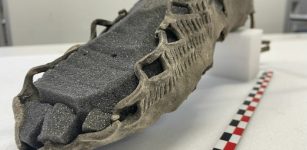Siege Of Alesia: Last Decisive Battle That Ended Gallic Independence In France And Belgium
A. Sutherland - AncientPages.com - The Battle of Alesia took place in September 52 BC. It was the culmination of Caesar's successful campaigns to bring Gaul (modern France) into the Roman Empire.
For many years, Caesar had marched his soldiers across the country humiliating and slaughtering all Celtic tribes that resisted Roman rule. It took time but he finally ended Gallic independence in France and Belgium.

About one million Gauls had been sold as slaves and an equal number had been massacred; the remaining five million people had no choice – they accepted Roman rule.
Despite the victory at Gergovia, the Arverni king, Vercingetorix, was reluctant to fight in the open field against the Roman forces and still led guerrilla raids and used scorched-earth tactics.
He knew his enemy, who was engaged in the Gallic Wars (58-50 BC); he knew that Caesar conquered the Gallic peoples one by one and these successes brought him political prestige in Rome and great wealth through the spoils of wars and the sale of war captives as slaves.

The walls stretched for approximately 25 miles, connecting with more than 50 miles of trenches, 23 forts, turrets, palisades and other obstacles disturbing the approaching Gallic warriors.
Now, Caesar had to confront Gallic rebellions, which threatened his control over Gaul. The next his success came when Vercingetorix’ forces attacked him north-west of Dijon, in eastern Gaul; the Gallic attack was resisted by Roman legions supported by the Germanic cavalry.
The confidence of the rebels was shaken and Vercingetorix withdrew to Alesia, and closed its fortifications. Caesar used to pass up such an opportunity, stopped the march south and chased the fleeing Gauls.
Commanding fewer than 50,000 legionnaires, Caesar began a siege. Caesar’s made his decision to continue the siege of Alesia and forcing the Gallic surrender by starvation. Approximately 80,000 men were stationed in Alesia, together with the local civilian population, so it was obvious that the city’s food supply could not last long.
See also:
Vercingetorix: Greatest Of All Gallic Leaders And Hero Of The French People
Gallic Leader Vercingetorix In Victorious Battle Of Gergovia, 52 BC
Wilhelm Tell: Famous Legendary Crossbowman And Swiss Patriot – Symbol Of Freedom And Dignity
Vercingetorix dispatched his cavalry to rally reinforcements from across Gaul, and in turn the Romans decided to construct a double wall of fortifications around Alesia. The strengthening was facing towards and away from the city.
The walls stretched for approximately 25 miles, connecting with more than 50 miles of trenches, 23 forts, turrets, palisades and other obstacles disturbing the approaching Gallic warriors.
When Gallic support force arrived, the Romans had to face 80,000 men in Alesia and about 250,000 foot soldiers along with 8,000 cavalry attacking from outside the city.
After two days of heavy fighting, Caesar’s army was in trouble and on the third day, the Gauls captured the Roman camp, playing an important role in the Roman defense. To Caesar’s help came his German cavalry, which outflanked the Gallic forces and attacked them from behind and thus, the battle eventually turned to the Roman advantage.
The great Gallic leader, Vercingetorix, decided to surrender the next day. The three-day battle of Alesia was over; the Romans had won a decisive victory, destroying the powerful and very brave Gallic tribes.
The nation of Gaul was turned into a province of the Roman Empire. About one million Gauls had been sold as slaves and an equal number had been massacred; the remaining five million people had no choice – they accepted Roman rule.
After his surrender, Vercingetorix the Gaul, was taken to Rome where he was kept prisoner until he was executed in Julius Caesar's triumph of 46 B.C.
Written by – A. Sutherland AncientPages.com Staff Writer
Copyright © AncientPages.com All rights reserved. This material may not be published, broadcast, rewritten or redistributed in whole or part without the express written permission of AncientPages.com
Expand for referencesReferences:
S. Sandler, Ground Warfare
M. L. Lanning, Battle 100: The Stories Behind History's Most Influential Battles
More From Ancient Pages
-
 DNA Study Of ‘Cheddar Man’ Re-Writes Ancient History Of Britain
Archaeology | Feb 9, 2018
DNA Study Of ‘Cheddar Man’ Re-Writes Ancient History Of Britain
Archaeology | Feb 9, 2018 -
 Revealing 1,200 Years Of Arctic Canadian Cultures And Settlements In Canada
Archaeology | Jul 11, 2024
Revealing 1,200 Years Of Arctic Canadian Cultures And Settlements In Canada
Archaeology | Jul 11, 2024 -
 Ancient Tomb Of ‘Bird Oracle Markos’ Unearthed In Bergama (Pergamon), Turkey
Archaeology | Sep 6, 2022
Ancient Tomb Of ‘Bird Oracle Markos’ Unearthed In Bergama (Pergamon), Turkey
Archaeology | Sep 6, 2022 -
 Brain Development Differs Between Neanderthals And Modern Humans – New Study
Archaeology | Sep 5, 2022
Brain Development Differs Between Neanderthals And Modern Humans – New Study
Archaeology | Sep 5, 2022 -
 Early Homo Sapiens From Southeast Asia Could Adapt To A Rainforest Environment
Archaeology | Oct 17, 2021
Early Homo Sapiens From Southeast Asia Could Adapt To A Rainforest Environment
Archaeology | Oct 17, 2021 -
 Paleolithic Workshop Unearthed In The İnkaya Cave In The Turkish Western Province Of Çanakkale
Archaeology | Oct 29, 2022
Paleolithic Workshop Unearthed In The İnkaya Cave In The Turkish Western Province Of Çanakkale
Archaeology | Oct 29, 2022 -
 What Can Grinding Stones Reveal About Europe’s Earliest Neolithic Communities?
Archaeology | Feb 28, 2025
What Can Grinding Stones Reveal About Europe’s Earliest Neolithic Communities?
Archaeology | Feb 28, 2025 -
 On This Day In History: Feast Day Of The Venerable Bede – Remarkable Priest, Monk And Scholar – On May 25, 735
News | May 25, 2016
On This Day In History: Feast Day Of The Venerable Bede – Remarkable Priest, Monk And Scholar – On May 25, 735
News | May 25, 2016 -
 Dragon Man: New Species Of Human May Replace Neanderthals As Our Closest Relative
Archaeology | Jun 26, 2021
Dragon Man: New Species Of Human May Replace Neanderthals As Our Closest Relative
Archaeology | Jun 26, 2021 -
 Pottery Found On Jiigurru/Lizard Island Rewrites Aboriginal History
Archaeology | Apr 12, 2024
Pottery Found On Jiigurru/Lizard Island Rewrites Aboriginal History
Archaeology | Apr 12, 2024 -
 Ancient Secrets Of Rare Maps Of Judah Ben Zara Revealed
Artifacts | Sep 20, 2022
Ancient Secrets Of Rare Maps Of Judah Ben Zara Revealed
Artifacts | Sep 20, 2022 -
 10 Remarkable Jain Temples – Marvelous Ancient Architecture And Stone Carvings
Featured Stories | Dec 17, 2015
10 Remarkable Jain Temples – Marvelous Ancient Architecture And Stone Carvings
Featured Stories | Dec 17, 2015 -
 Startling Roman-Looking Sandal Discovered Buried Deep Beneath The Snow In Norwegian Mountains
Archaeology | Apr 13, 2022
Startling Roman-Looking Sandal Discovered Buried Deep Beneath The Snow In Norwegian Mountains
Archaeology | Apr 13, 2022 -
 Antonine Wall: Impressive Roman Frontier Built By Empire’s Three Legions In Scotland
Civilizations | Jan 18, 2018
Antonine Wall: Impressive Roman Frontier Built By Empire’s Three Legions In Scotland
Civilizations | Jan 18, 2018 -
 Marble Head Of Roman Emperor Augustus Unearthed In Isernia, Italy
Archaeology | May 7, 2021
Marble Head Of Roman Emperor Augustus Unearthed In Isernia, Italy
Archaeology | May 7, 2021 -
 World’s Oldest And Largest Maya Structure Revealed By LIDAR
Archaeology | Jun 9, 2020
World’s Oldest And Largest Maya Structure Revealed By LIDAR
Archaeology | Jun 9, 2020 -
 Is ‘Someone’ Regularly Altering The Course Of History? – Unexplained Events – Part 2
Ancient Mysteries | Dec 3, 2020
Is ‘Someone’ Regularly Altering The Course Of History? – Unexplained Events – Part 2
Ancient Mysteries | Dec 3, 2020 -
 Number ‘Seven’: Mystical Number Of The Universe And One Of The Most Sacred Numbers
Ancient Symbols | Feb 14, 2017
Number ‘Seven’: Mystical Number Of The Universe And One Of The Most Sacred Numbers
Ancient Symbols | Feb 14, 2017 -
 Ptolemaic Granite Sarcophagus Found In Alexandria, Egypt
Archaeology | Jul 6, 2018
Ptolemaic Granite Sarcophagus Found In Alexandria, Egypt
Archaeology | Jul 6, 2018 -
 Manasota People: Will 1,300-year-Old Village Tell Us About Their Lives?
Archaeology | Jan 11, 2016
Manasota People: Will 1,300-year-Old Village Tell Us About Their Lives?
Archaeology | Jan 11, 2016


